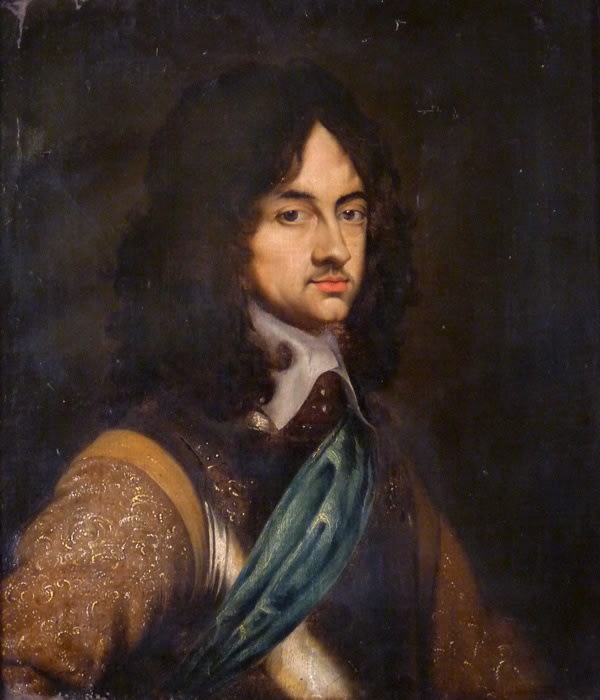
Studio of Adriaen Hanneman
Portrait of King Charles II
Oil on canvas
27 1.2 x 23 ½ inches, 70 x 60 cm
Philip Mould & Co.
To view all current artworks for sale visit philipmould.com This rare portrait of Charles II was painted during his exile in Europe following the Royalist defeat after the Civil...
To view all current artworks for sale visit philipmould.com
This rare portrait of Charles II was painted during his exile in Europe following the Royalist defeat after the Civil War. Portraits were particularly important as a means of keeping Charles’ cause alive, and the putative king sat to a number of artists, both for larger images and miniatures. Here, he is portrayed wearing the blue sash of a Knight of the Garter and armour, which would have struck contemporary viewers as doubly symbolic; the Garter was the pre-eminent symbol of royal authority, while the armour indicated Charles’ martial spirit and determination to fight to regain his throne.
At the time the portrait was painted, in about 1648, Charles was still desperately trying to recover the Royalist position. His father Charles I was in captivity but had not yet been executed, and there remained optimistic signs that the Parliamentarians had not yet cemented their hold on power. Charles was in regular dialogue with the Scots, who largely then remained loyal to the monarchy, and there were also hopes of regaining ground in Ireland. Within a year, however, Charles’s position had become far bleaker. Relations with the Scots foundered on the subject of religion, Cromwell secured Ireland, and Charles I’s execution seemed certain to end any hopes of a swift Royalist recovery.
Adriaen Hanneman’s original version of this portrait of Charles II is now lost, but was most likely a three quarter length. The present portrait is one of only a few high-quality versions done in Hanneman’s studio under his supervision. Hanneman was effectively the official court painter during Charles’ exile in The Hague, and was popular amongst the King’s courtiers for a number of reasons. Although he had been born and trained in The Hague, under Anthony van Ravestyn, he traveled to London in 1626, and his subsequent English connections proved invaluable for a number of reasons. First, he had almost certainly worked as an assistant to Van Dyck in London in the 1630s; secondly, he painted in the Van Dyckian style so favoured by Royalists; and finally, he spoke fluent English. When, from 1648 onwards, the Royalist court in exile settled at The Hague, Hanneman was called on to paint many of the leading exiles, such as the Earl of Clarendon [with Philip Mould Ltd], and Charles I’s younger son, Henry, Duke of Gloucester [National Gallery of Art Washington].
This rare portrait of Charles II was painted during his exile in Europe following the Royalist defeat after the Civil War. Portraits were particularly important as a means of keeping Charles’ cause alive, and the putative king sat to a number of artists, both for larger images and miniatures. Here, he is portrayed wearing the blue sash of a Knight of the Garter and armour, which would have struck contemporary viewers as doubly symbolic; the Garter was the pre-eminent symbol of royal authority, while the armour indicated Charles’ martial spirit and determination to fight to regain his throne.
At the time the portrait was painted, in about 1648, Charles was still desperately trying to recover the Royalist position. His father Charles I was in captivity but had not yet been executed, and there remained optimistic signs that the Parliamentarians had not yet cemented their hold on power. Charles was in regular dialogue with the Scots, who largely then remained loyal to the monarchy, and there were also hopes of regaining ground in Ireland. Within a year, however, Charles’s position had become far bleaker. Relations with the Scots foundered on the subject of religion, Cromwell secured Ireland, and Charles I’s execution seemed certain to end any hopes of a swift Royalist recovery.
Adriaen Hanneman’s original version of this portrait of Charles II is now lost, but was most likely a three quarter length. The present portrait is one of only a few high-quality versions done in Hanneman’s studio under his supervision. Hanneman was effectively the official court painter during Charles’ exile in The Hague, and was popular amongst the King’s courtiers for a number of reasons. Although he had been born and trained in The Hague, under Anthony van Ravestyn, he traveled to London in 1626, and his subsequent English connections proved invaluable for a number of reasons. First, he had almost certainly worked as an assistant to Van Dyck in London in the 1630s; secondly, he painted in the Van Dyckian style so favoured by Royalists; and finally, he spoke fluent English. When, from 1648 onwards, the Royalist court in exile settled at The Hague, Hanneman was called on to paint many of the leading exiles, such as the Earl of Clarendon [with Philip Mould Ltd], and Charles I’s younger son, Henry, Duke of Gloucester [National Gallery of Art Washington].
Provenance
English Private Collection
Be the first to hear about our available artworks
* denotes required fields
We will process the personal data you have supplied in accordance with our privacy policy (available on request). You can unsubscribe or change your preferences at any time by clicking the link in our emails.